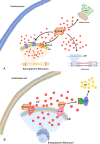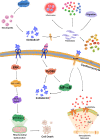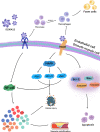S100 proteins in cardiovascular diseases
- PMID: 37217870
- PMCID: PMC10204201
- DOI: 10.1186/s10020-023-00662-1
S100 proteins in cardiovascular diseases
Abstract
Cardiovascular diseases have become a serious threat to human health and life worldwide and have the highest fatality rate. Therefore, the prevention and treatment of cardiovascular diseases have become a focus for public health experts. The expression of S100 proteins is cell- and tissue-specific; they are implicated in cardiovascular, neurodegenerative, and inflammatory diseases and cancer. This review article discusses the progress in the research on the role of S100 protein family members in cardiovascular diseases. Understanding the mechanisms by which these proteins exert their biological function may provide novel concepts for preventing, treating, and predicting cardiovascular diseases.
Keywords: Cardiovascular diseases; RAGE; S100 proteins; TLR-4.
© 2023. The Author(s).
Conflict of interest statement
The authors declare that they have no known competing financial interests or personal relationships that could have appeared to influence the work reported in this paper.
Figures





Similar articles
-
RAGE: a single receptor for several ligands and different cellular responses: the case of certain S100 proteins.Curr Mol Med. 2007 Dec;7(8):711-24. doi: 10.2174/156652407783220688. Curr Mol Med. 2007. PMID: 18331229 Review.
-
Expression, purification and fluorine-18 radiolabeling of recombinant S100 proteins--potential probes for molecular imaging of receptor for advanced glycation endproducts (RAGE) in vivo.Protein Expr Purif. 2008 Feb;57(2):143-52. doi: 10.1016/j.pep.2007.10.009. Epub 2007 Oct 22. Protein Expr Purif. 2008. PMID: 18039581
-
Binding of S100 proteins to RAGE: an update.Biochim Biophys Acta. 2009 Jun;1793(6):993-1007. doi: 10.1016/j.bbamcr.2008.11.016. Epub 2008 Dec 11. Biochim Biophys Acta. 2009. PMID: 19121341 Review.
-
The importance of Ca2+/Zn2+ signaling S100 proteins and RAGE in translational medicine.Front Biosci (Schol Ed). 2011 Jun 1;3(4):1232-62. doi: 10.2741/223. Front Biosci (Schol Ed). 2011. PMID: 21622268 Review.
-
HMGB1, S100 proteins and other RAGE ligands in cancer - markers, mediators and putative therapeutic targets.Biomed Pap Med Fac Univ Palacky Olomouc Czech Repub. 2016 Mar;160(1):1-10. doi: 10.5507/bp.2016.003. Epub 2016 Feb 3. Biomed Pap Med Fac Univ Palacky Olomouc Czech Repub. 2016. PMID: 26847418 Review.
Cited by
-
Tumor‑associated macrophages activated in the tumor environment of hepatocellular carcinoma: Characterization and treatment (Review).Int J Oncol. 2024 Oct;65(4):100. doi: 10.3892/ijo.2024.5688. Epub 2024 Sep 6. Int J Oncol. 2024. PMID: 39239752 Free PMC article. Review.
-
Quantitative Assessment of Intracellular Effectors and Cellular Response in RAGE Activation.Arch Intern Med Res. 2024;7(2):80-103. doi: 10.26502/aimr.0168. Epub 2024 Apr 26. Arch Intern Med Res. 2024. PMID: 38784044 Free PMC article.
-
Role of the Receptor for Advanced Glycation End Products (RAGE) and Its Ligands in Inflammatory Responses.Biomolecules. 2024 Dec 4;14(12):1550. doi: 10.3390/biom14121550. Biomolecules. 2024. PMID: 39766257 Free PMC article. Review.
-
On-Site Melanoma Diagnosis Utilizing a Swellable Microneedle-Assisted Skin Interstitial Fluid Sampling and a Microfluidic Particle Dam for Visual Quantification of S100A1.Adv Sci (Weinh). 2024 Apr;11(16):e2306188. doi: 10.1002/advs.202306188. Epub 2024 Feb 28. Adv Sci (Weinh). 2024. PMID: 38417122 Free PMC article.
-
Targeting tumor-intrinsic S100 calcium-binding protein A1 augments antitumor immunity and potentiates immunotherapy efficacy.Signal Transduct Target Ther. 2025 Mar 17;10(1):99. doi: 10.1038/s41392-025-02190-2. Signal Transduct Target Ther. 2025. PMID: 40090947 Free PMC article.
References
Publication types
MeSH terms
Substances
LinkOut - more resources
Full Text Sources
Medical

